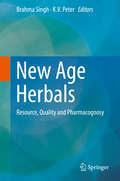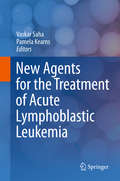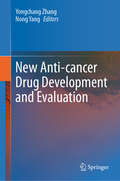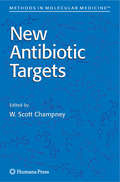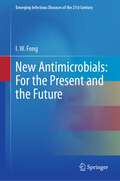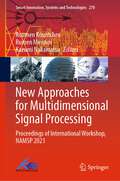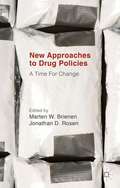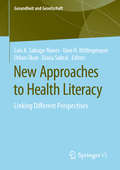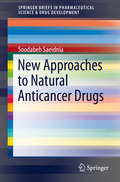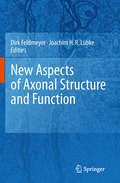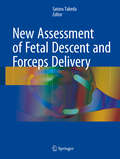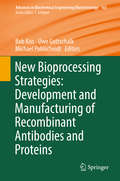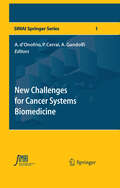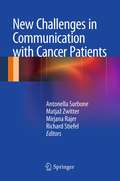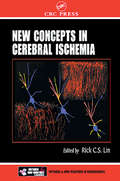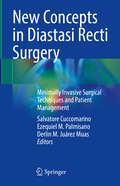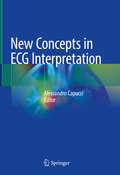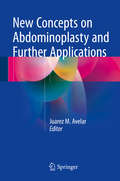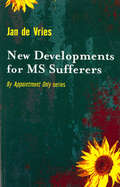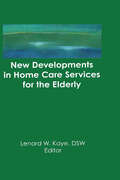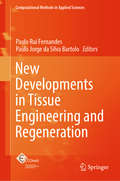- Table View
- List View
New Age Herbals: Resource, Quality And Pharmacognosy
by Brahma Singh K. V. PeterImportance of herbs (medicinal plants) can hardly be overemphasized. They are exploited for manyfold applications, ranging from phytopharmaceuticals, to nutraceuticals, to cosmetics and many others. Keeping in view the richness of herbs and their vast potential, this book collates the most up-to-date knowledge of important herbs and herbals. The book also gives an overview of some issues causing hindrance in the promotion of herbals. This book attempts to compile the rich experience of experts working on various herbs. New age single plant species, having multiple medicinal traits worth exploiting i.e. Hippophae rhamnoides (seabuckthorn), and Morinda citrifolia (noni) also find place as full chapters in the book.
New Agents for the Treatment of Acute Lymphoblastic Leukemia
by Vaskar Saha Pamela KearnsThe majority of cancers present at a relatively advanced stage in which invasion within the primary organ is well established and metastases to lymph and distant organs are either clinically apparent or present at the microscopic level. However, it is increasingly recognized that the natural history of cancer formation is a long and complex path taking many years to develop to a clinically apparent stage in most cases. Furthermore, for most solid tumours there is a pre-invasive or intraepithelial stage of disease. This affords the opportunity for early detection and prevention of invasive disease and hence a cure. However, with this advancing knowledge comes a whole plethora of questions which will be explored in this monograph. Firstly, we need to understand the global burden of pre-invasive disease and what the public health implications might be for wide-scale screening programmes. In the western world we already have experience of screening for cervical, breast, prostate and more recently colon cancer. As well as their potential benefits these programmes have financial and psychosocial implications which need to be carefully weighed. This is especially true since many pre-invasive lesions will not progress to cancer in a individual's lifetime. In addition, there are questions concerning whether screening reduces the cancer burden or in fact distorts the survival figures through lead-time bias. Secondly, at the level of epidemiology and molecular pathogenesis there are important questions regarding the aetiology of pre-invasive lesions; an understanding of which might lead to possible chemopreventive strategies. For example, it would be helpful to know the extent to which the likelihood of developing a pre-invasive lesion is influenced by lifestyle or genetic factors and how these factors influence the risk of progression to invasive disease. At the molecular level we need to understand the pathways and molecular mechanisms, both genetic and epigenetic, by which cells achieve the capacity to invade. Thirdly, in order make clinical progress we need biomarkers to identify and risk stratify individuals with pre-invasive lesions. These biomarkers might be applied to the serum as in Prostate Specific Antigen in prostate cancer or be applied to tissue samples, such as oestrogen receptor status in breast cancer. In order to utilize biomarkers in the context of a screening programme there are issue around the invasiveness of the test as well as its positive and negative predictive value. With advances in molecular imaging there is now the exciting possibility of incorporating a molecular tag to a non-invasive imaging modality. Fourthly, in order to justify screening early detection must be coupled to a treatment strategy. If the chemopreventive agent is very well tolerated, then as well as targeting high risk groups, one might consider treatment at the population level. Aspirin is one such drug which has been extensively assessed in the context of colon cancer chemoprevention trials. Trials of aspirin chemoprevention are now being applied to other cancers such as oesophageal adenocarcinoma and since many individuals take aspirin for .chemoprevention of cardiovascular disease the cancer incidence can be ascertained in these populations. In order to understand the more general issues raised from the discussions above it is useful to consider disease specific examples. Our understanding of pre-invasive disease varies according to the organ site and there are lessons to be learned from these experiences. For example, there is now the prospect of a vaccine for cervical cancer with important questions about how this might be applied to the high incidence areas of the developing world. On the other hand, ductal carcinoma in situ is currently treated by mastectomy which is more radical than the treatment received by many women with invasive disease. Oesophageal adenocarcinoma, which is my own area of expertise is interesting because of the rapid rise in incidence in the western world and the clinically accessible pre-invas...
New Anti-cancer Drug Development and Evaluation
by Yongchang Zhang Nong YangThis book aims to help researchers to understand the current status of new drug development in China and major events experienced in the development of new drugs. It also helps clinicians and basic research scientists to grasp the types, indications, and adverse reactions of common new drugs; clarifies key events experienced during the launch of new drugs; and discusses future perspectives of clinical medicine development. This book is also beneficial to clinicians by helping them to better become physician scientists.
New Antibiotic Targets
by W. Scott ChampneyThis book examines specific techniques which can be used to explore new drug targets and the effectiveness of new antibiotics. By testing new antimicrobial agents and modified existing drugs, the most vulnerable cell processes, such as cell wall and membrane synthesis, DNA replication, RNA transcription and protein synthesis, can be better exploited. This in-depth volume, however, delves even deeper by identifying additional novel cellular targets for these new therapies. The book will provide laboratory investigators with the vital tools they need to test the antimicrobial potential of products and to curb the rise of so many infectious diseases.
New Antimicrobials: For the Present and the Future (Emerging Infectious Diseases of the 21st Century)
by I.W. FongThis is a timely and essential companion to the recently published Antimicrobial Resistance in the 21st Century, Second Edition. Antimicrobial resistance is a major threat to global population health, with government reports projecting it could result in over 10 million deaths in the next 35 years. Development of new agents to combat this threat is one of the WHO's top priorities, but in 2017, it conceded that the current drug development pipeline was insufficient to mitigate the threat. This book discusses recent progress and bolster new agent discovery and development, by providing researchers and students who will soon enter the field with a thorough guide to the advancements made in the last decade. Coverage includes new systemic antimicrobials approved since 2010, with detailed analysis of antibiotics, antivirals, antifungals, and antiparasitics, as well as agents in development for future use. Discussion of each drug will include its chemical nature, pharmacology/pharmacokinetics, antimicrobial spectrum, dosage, adverse reactions, drug interactions, microbial resistance, indications, clinical efficacy compared to older agents, and lists of similar agents with cost comparison. This volume is designed for researchers and students of infectious disease and medical microbiology, as well as clinicians in need of a comprehensive guide to newly developed agents.
New Approaches for Multidimensional Signal Processing: Proceedings of International Workshop, NAMSP 2021 (Smart Innovation, Systems and Technologies #270)
by Kazumi Nakamatsu Roumen Kountchev Rumen MironovThis book comprises a collection of papers presented at the International Workshop on New Approaches for Multidimensional Signal Processing (NAMSP 2021), held at Technical University of Sofia, Sofia, Bulgaria, during 08–10 July 2021. The book covers research papers in the field of N-dimensional multicomponent image processing, multidimensional image representation and super-resolution, 3D image processing and reconstruction, MD computer vision systems, multidimensional multimedia systems, neural networks for MD image processing, data-based MD image retrieval and knowledge data mining, watermarking, hiding and encryption of MD images, MD image processing in robot systems, tensor-based data processing, 3D and multi-view visualization, forensic analysis systems for MD images and many more.
New Approaches to Asian History: Epidemics in Modern Asia
by Robert PeckhamEpidemics have played a critical role in shaping modern Asia. Encompassing two centuries of Asian history, Robert Peckham explores the profound impact that infectious disease has had on societies across the region: from India to China and the Russian Far East. The book tracks the links between biology, history, and geopolitics, highlighting infectious disease's interdependencies with empire, modernization, revolution, nationalism, migration, and transnational patterns of trade. By examining the history of Asia through the lens of epidemics, Peckham vividly illustrates how society's material conditions are entangled with social and political processes, offering an entirely fresh perspective on Asia's transformation.
New Approaches to Drug Discovery
by Stefan Jaroch Ulrich Nielsch Ulrike FuhrmannThis volume gives an overview ofstate of the art technologies and future developments in the field ofpreclinical pharmaceutical research. A balanced mix of experts from academiaand industry give insight in selected new developments in the drug discoverypathway. The topics cover the different parts of the drug discovery process,starting with new developments in the target identification and validationarea. The lead generation part as a next step focuses on the requirements andtechnologies to identify new small molecules as lead compounds for furtheroptimization; in a second section the technologies to identify biologics asleads are addressed. The final part focuses on the pharmacological models andtechnologies to characterize new compounds and the impact of biomarkers to facilitatethe transfer of drug candidates into the development phase.
New Approaches to Drug Policies: A Time for Change
by Marten W. Brienen Jonathan D. RosenThe U. S. -led war on drugs has failed: drugs remain purer, cheaper and more readily available than when the war on drugs began in 1971. The drug war also has resulted in extreme levels of violence as drug traffickers and organized criminals compete for control of territory. Prohibitionist policies have destroyed the lives of millions of people as prisons warehouse drug offenders. This important volume represents an effort to map new approaches to drug policies. The contributors write from various disciplinary backgrounds and provide crucial insights on a wide-range of topics, including the gang-drug nexus, delinquency, legalization, trafficking, decriminalization, intervention programs and prison reform. This volume also provides a number of policy solutions and alternatives to the current drug strategies. Includes contributions from: Marten W. Brienen, Ted Galen Carpenter, Roger G. Dunham, Gregory Fulkerson, Betty Horwitz, Caitlin Elizabeth Hughes, Hanna Samir Kassab, Ana Maria Lobos, Bradford R. McGuinn, Fida Mohammad, Keri O'Neal, J. Bryan Page, Susan A. Phillips, Vanessa Rayan, Jonathan D. Rosen, Alex Stevens, Steven L. West, and Marcelo Rocha e Silva Zorovich.
New Approaches to Health Literacy: Linking Different Perspectives (Gesundheit und Gesellschaft)
by Orkan Okan Uwe H. Bittlingmayer Diana Sahrai Luis A. Saboga-NunesIn this anthology of health literacy, drawing on New Social Literacy studies and contemporary debates on equity, we discuss health literacy within German regional and cultural contexts as well as in selected non-European regions, such as in Asia and South America. Topics include unique reviews on health literacy, new empirical results on different population groups, in-depth ethnographic insights into social contexts, interventions intended to improve health literacy, and innovative theoretical dialogs. The discussions within this book provide new ideas and intriguing new results, also shedding light on the explanatory power of the health literacy concept as well as its boundaries.
New Approaches to Natural Anticancer Drugs
by Soodabeh SaeidniaThis book provides an up-to-date review of recently identified natural anti-tumor compounds from various natural origins including plants, fungi, endophytic fungi and marine organisms. It also includes discussion of new areas such as biotechnology and nanoparticles. Chapters explain the challenges and developments in anti-cancer drug discovery approaches, traditional remedies for prevention and treatment of cancer, marine-derived anti-cancer compounds, and antibiotics used as anti-cancer agents, as well as different classes of terpenoids and carbohydrates, which have been the subject of discussion in this field as efficient anti-cancer candidates. This book will be a concise guide for researchers in the field of pharmaceutical sciences, students and residents in pharmacy and medicine as well as those researching phytochemistry and natural products.
New Aspects of Axonal Structure and Function
by Joachim Lübke Dirk FeldmeyerAxons are neuronal output elements and are responsible for the transfer and processing of signals from one neuron to another, even over very large distances. For a given neuronal cell type, axons are unique and display very heterogeneous patterns with respect to shape, length and target structure. Axons are the usually long process of a nerve fiber that generally conducts impulses away from the body of the nerve cell. This book is intended to summarize recent findings covering morphological, physiological, developmental, computational and pathophysiological aspects of axons. It attempts to cover new findings concerning axonal structure and functions together with their implications for signal transduction, processes implicated in the formation of axonal arbors and the transport of subcellular elements to their targets, and finally how a dysfunction in one or several of these steps could lead to axonal degeneration and ultimately to neurodegenerative diseases.
New Assessment of Fetal Descent and Forceps Delivery
by Satoru TakedaThis book offers a highly informative guide to forceps devices and delivery techniques. Extensive figures and animations offer readers vivid insights into the fetus station, pelvis, and inserted forceps. The book covers normal presentation and abnormal rotation, presentation and attitudes, and especially focuses on the assessment of fetal descent. It discusses the problem with conventional fetal station, and explains the revised one based on the trapezoidal plane. Instrumental delivery is chosen in cases of worrisome fetal status, protracted labor, or maternal fatigue. Forceps can provides a greater pulling power than vacuum extraction, and the fetus can be delivered in a short time, though this technique calls for experience and technical proficiency. The book argues that in order to ensure safe and reliable forceps delivery, assessment of the fetal station and the site of the largest fetal head circumference is critical. The book offers a new and indispensable reference guide for all obstetricians, not only for residents, but also for all experienced professionals involved in the training of beginners, and even for those using vacuum extraction who would like to assess the fetus more objective and practically.
New Bioprocessing Strategies: Development and Manufacturing of Recombinant Antibodies and Proteins (Advances in Biochemical Engineering/Biotechnology #165)
by Uwe Gottschalk Bob Kiss Michael PohlscheidtThis book review series presents current trends in modern biotechnology. The aim is to cover all aspects of this interdisciplinary technology where knowledge, methods and expertise are required from chemistry, biochemistry, microbiology, genetics, chemical engineering and computer science.Volumes are organized topically and provide a comprehensive discussion of developments in the respective field over the past 3-5 years. The series also discusses new discoveries and applications. Special volumes are dedicated to selected topics which focus on new biotechnological products and new processes for their synthesis and purification.In general, special volumes are edited by well-known guest editors. The series editor and publisher will however always be pleased to receive suggestions and supplementary information. Manuscripts are accepted in English.
New Boss, New-Year Bride
by Lucy ClarkObstetrician Melissa Clarkson arrives in the small town of Didja on New Year's Eve--and finds herself sharing a sizzling kiss with her oh-so-dreamy new boss at the stroke of midnight!However much Melissa and Joss try to keep things strictly professional, the attraction between them is undeniably electric. But Melissa has come to Didja to find the family she's never known, and romance is most definitely not on her agenda!The people of the small Outback town fall for Melissa, as does Joss--and this New Year he wants Melissa to unpack her suitcases, for good!
New Challenges for Cancer Systems Biomedicine
by Alberto D'Onofrio Alberto Gandolfi Paola CerraiThe future of oncology seems to lie in Molecular Medicine (MM). MM is a new science based on three pillars. Two of them are evident in its very name and are well known: medical science and molecular biology. However, there is a general unawareness that MM is firmly based on a third, and equally important, pillar: Systems Biomedicine. Currently, this term denotes multilevel, hierarchical models integrating key factors at the molecular, cellular, tissue, through phenotype levels, analyzed to reveal the global behavior of the biological process under consideration. It becomes increasingly evident that the tools to construct such complex models include, not only bioinformatics and modern applied statistics, as is unanimously agreed, but also other interdisciplinary fields of science, notably, Mathematical Oncology, Systems Biology and Theoretical Biophysics.
New Challenges in Communication with Cancer Patients
by Richard Stiefel Antonella Surbone Matjaž Zwitter Mirjana RajerThe relationship between oncologists and their cancer patients is rapidly evolving. Oncologists and other cancer professionals master new anticancer and supportive treatment options, while working under increasing economic pressure and time constraints, and are often unprepared to deal with all the challenges of their new position in a therapeutic relationship with cancer patients and families. Good communication is as essential as are modern laboratory tests and sophisticated diagnostics to achieve the best clinical results. This book updates the evolution of truth-telling and communication patterns worldwide and offers insights into the recent trends and emerging challenges in communication with cancer patients and families. New Challenges in Communication with Cancer Patients is an invaluable resource to medical professionals, educators and patients in establishing a strong and effective partnership built on trust and mutual understanding.
New Concepts in Cerebral Ischemia (Frontiers in Neuroscience)
by Rick C.S. LinApproximately half a million Americans suffer brain ischemic episodes every year. These brain strokes are the third leading cause of death in the United States and the number-one cause of permanent disability. Over the past decade, we have made extensive attempts to understand the biological mechanisms that underlie stroke-induced neuronal injury. Providing a detailed description of the techniques and theories employed in both basic and clinical research, New Concepts in Cerebral Ischemia delineates the mechanisms underlying neuronal damage induced by ischemia. The book covers methods to elucidate the pathogenesis of ischemia, technologies used in the design of specific strategies to protect neurons from further injury, and new approaches to treat patients with acute ischemic episodes. It includes methods and therapeutic approaches for neuronal protection against acute and chronic ischemic episodes and describes new animal models for ischemia research including the application of transgenic animals.
New Concepts in Diagnosis and Therapy of Pancreatic Adenocarcinoma
by Andrea Laghi Albert L. BaertThis book adopts a multidisciplinary approach to examine in detail a range of interesting new concepts in the diagnosis and therapy of pancreatic adenocarcinoma. It is divided into three parts. The first part provides an epidemiological and clinical overview of the disease, followed by an update on pathological findings, including new discoveries in the area of molecular biology. The second part, on diagnosis, offers detailed and comprehensive information on the advantages and disadvantages of different imaging techniques, including nuclear medicine and endoscopic ultrasound. The concluding part gives a panoramic overview of the various therapeutic options, from surgery to chemotherapy and palliative approaches based on interventional endoscopy and radiology. This book will be a valuable source of information for clinicians involved in the management of pancreatic adenocarcinoma and for all who are interested in updating their knowledge of the disease, including fellows and senior residents.
New Concepts in Diastasi Recti Surgery: Minimally Invasive Surgical Techniques and Patient Management
by Salvatore Cuccomarino Ezequiel M. Palmisano Derlin M. Juárez MuasThis book sheds new light on the anatomy, pathophysiology, clinical implications, and surgical interventions for diastasis of the rectus abdominis muscles. Diastasis recti is a prevalent condition, affecting approximately one-third of women post-delivery. Often dismissed as merely an aesthetic issue, recent research over the past 15 years has revealed its profound functional implications on core stability, lumbar support, pelvic floor function, and the overall integrity of the antero-lateral abdominal wall. The chapters cover topics such as the latest advancements in minimally invasive surgery—including laparoscopic, endoscopic, and robotic techniques—highlighting how these methods effectively address the functional issues associated with diastasis recti. Readers will discover insights into how this condition can be a significant risk factor for linea alba hernias and the recurrence of umbilical and median incisional hernias. Contributions from renowned experts provide a comprehensive analysis of current research and personal experiences, making this book an essential resource for understanding and treating diastasis recti.
New Concepts in ECG Interpretation
by Alessandro CapucciThis book elucidates a number of new concepts on P-wave evaluation and QRS depolarization properties, and reports on several repolarization findings never covered in previous ECG books. The content is primarily based on case reports, some of which are compared in order to reveal their ostensibly small but significant differences. The book addresses a significant and lingering gap in ECG interpretation, which is the actual cause of many poor decisions in the diagnostic and therapeutic contexts. Further, the book has an interdisciplinary appeal, and will be of equal interest to professionals and scholars with an interest in cardiology and ECG interpretation.
New Concepts on Abdominoplasty and Further Applications
by Juarez M. AvelarThisbook documents the important advances that have been achieved in abdominoplastyover the past 15 years, in particular through the introduction of anontraumatic approach associated with minimal morbidity owing to the avoidanceof resection of abdominal panniculus and damage to the perforating vessels. Thesurgical principles of this procedure, including in combination withliposuction, are fully described by its developer, Juarez Avelar, with the aidof a wealth of color illustrations. A miniabdominoplasty option is alsodiscussed and recent significant technical contributions such as various newplication techniques and means of minimizing complications are clearlypresented. In addition, a series of chapters explain how the surgicalprinciples underlying the described nontraumatic method of abdominoplasty cannow be applied to other areas of the body, for example to improverhytidoplasty, ear reconstruction, body contouring, and medial thigh lifting. This book enables the plastic surgeon to apply the latest abdominoplastytechniques effectively and safely.
New Developments for MS Sufferers
by Jan de VriesThis book is the follow-up to Jan de Vries's world-wide success, Multiple Sclerosis. Drawing on nearly 40 years' experience of treating MS sufferers, De Vries now proves that a gluten-free diet is highly beneficial - not only as a means of controlling MS, but also for those suffering from autism and schizophrenia. This essential book contains a simple and thorough guide on how to follow a gluten-free diet in everyday life. Jayne Martin, an MS sufferer successfully treated by de Vries, shares with readers the challenges she has overcome in following the diet and provides tasty and easy-to-follow recipes. New Developments for MS Sufferers is a practical, fascinating and worthwhile read for all those affected by this increasingly prevalent problem.
New Developments in Home Care Services for the Elderly: Innovations in Policy, Program, and Practice
by Lenard W KayeThis anthology responds to the recurring call for quality in home care service provision. It presents to agency administrators, managers, supervisors, and front line service providers a set of the most up-to-date policy, program, and practice developments in the field. Each contributor to New Developments in Home Care Services for the Elderly explores issues of client/staff diversity and the challenges associated with working with clients grappling with disabling conditions.Contributors in New Developments in Home Care Services for the Elderly explore issues of client/staff diversity and the challenges associated with working with clients grappling with various disabling conditions. Topics addressed include: alternative organizational models in home care the importation of high technology services into the home legal and ethical issues in home health care counseling homebound clients and their families clinical assessment tools and packages case management and the home care client home care entitlements and benefits evaluating and monitoring the effectiveness of in-home care marketing home health care services home care service experiences in other countriesNew Developments in Home Care Services for the elderly covers a continuum of care ranging from housekeeping services to self-care education, teaching, and training services to nursing and medically related services. Consequently, the information contained within this volume is of immediate relevance to a multidisciplinary audience having both direct (field) and indirect (office) service responsibilities in the home care organization. Social workers, nurses, business administrators, and public health professionals will find this an invaluable guide for providing effective home care services.
New Developments in Tissue Engineering and Regeneration (Computational Methods in Applied Sciences #51)
by Paulo Rui Fernandes Paulo Jorge da Silva BartoloThis volume presents a new contribution for the field of Tissue Engineering with a focus on the development of mathematical and computational methods that are relevant to understand human tissues, as well to model, design, and fabricate optimized and smart scaffolds.The multidisciplinary character of this field has motivated contributions from different areas with a common objective to replace damaged tissues and organs by healthy ones. This work treats tissue healing approaches, mathematic modelling for scaffold design and bio fabrication methods, giving the reader a broad view of the state of the art in Tissue Engineering. The present book contains contributions from recognized researchers in the field, who were keynote speakers in the Fourth International Conference on Tissue Engineering, held in Lisbon in 2015, and covering different aspects of Tissue Engineering. The book is strongly connected with the conference series of ECCOMAS Thematic Conferences on Tissue Engineering, an event that brings together a considerable number of researchers from all over the world, representing several fields of study related to Tissue Engineering.
